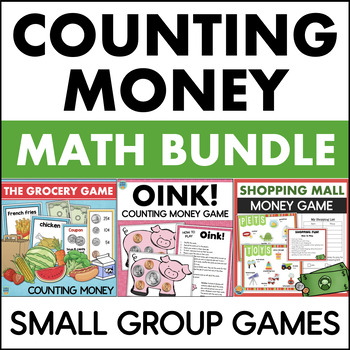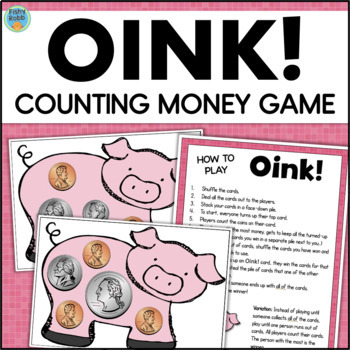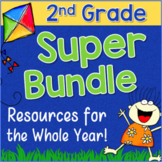Counting Money & Mixed Coins Math Games Centers Small Group Activities
- Zip
- Easel Activity
What educators are saying
Products in this Bundle (3)
Also included in
- This is a HUGE 2nd grade bundle containing 62 full-length resources (approx. 1000 pages) for teaching reading and math skills! It includes task cards, centers, stations, games, worksheets, and activities.The materials cover phonics, reading comprehension, grammar, sight words, addition, subtraction,Price $125.00Original Price $188.95Save $63.95
Description
This is a bundle of three math games for learning to count money (mixed sets of coins). These games are designed to be played in small groups with 2 to 4 players.
Includes:
- The Grocery Game
- OINK!
- Shopping Mall Game
THE GROCERY GAME
This is one the top-selling resources in my store! It is a highly engaging math activity that provides students with a hands-on way to practice counting money.
Players take turns picking food cards to fill up their grocery bags. Every card has a price, so students must pay for each item by counting out the correct amount of money from their "wallets."
Once all players have filled their bags, they all count their money to see who has the most left. For added challenge, two coupon cards allow players to subtract money from the purchase prices.
OINK!
This game is played like War with a fun variation. Cards are dealt out to the players. They all turn up their top card to see whose piggy bank has the most money. That person keeps the cards that were turned up.
If someone turns up an OINK! card, they get to steal another player's pile of cards.
SHOPPING MALL GAME
Students count their money and record how much they have on their shopping list. Then, they go shopping to see what they can buy. Students record their choices and add up the prices. Then, they have to answer the question - Do you have enough money?
This money game is one of my students' favorite activities. It's very simple with no prep. You can use it as it or add play money to make it feel more like real shopping!
Why use games to teach your students how to count money:
- Practice: Games all kids to practice counting money in a low-pressure, fun environment. This helps build their confidence and comfort level when it comes to handling money.
- Real-world application: Games that simulate real-life scenarios, such as grocery shopping, help kids understand how money is used in the real world. This helps them develop practical skills that will be useful later in life.
- Repetition: Games allow kids to repeat the process of counting money multiple times in a short amount of time. Repetition is a key component of learning.
✅ Don't forget to follow me to be notified about my weekly deals and when new products are added!






